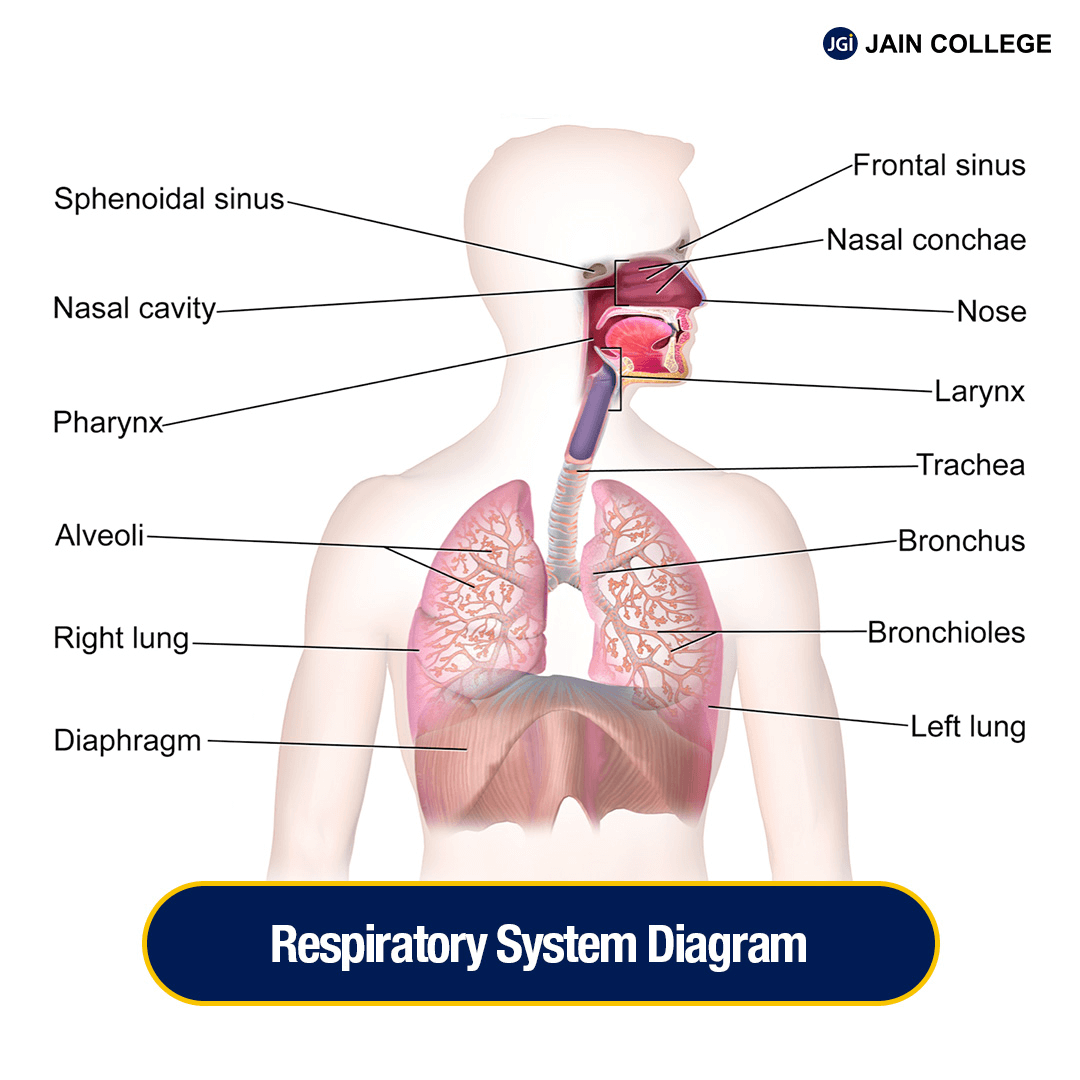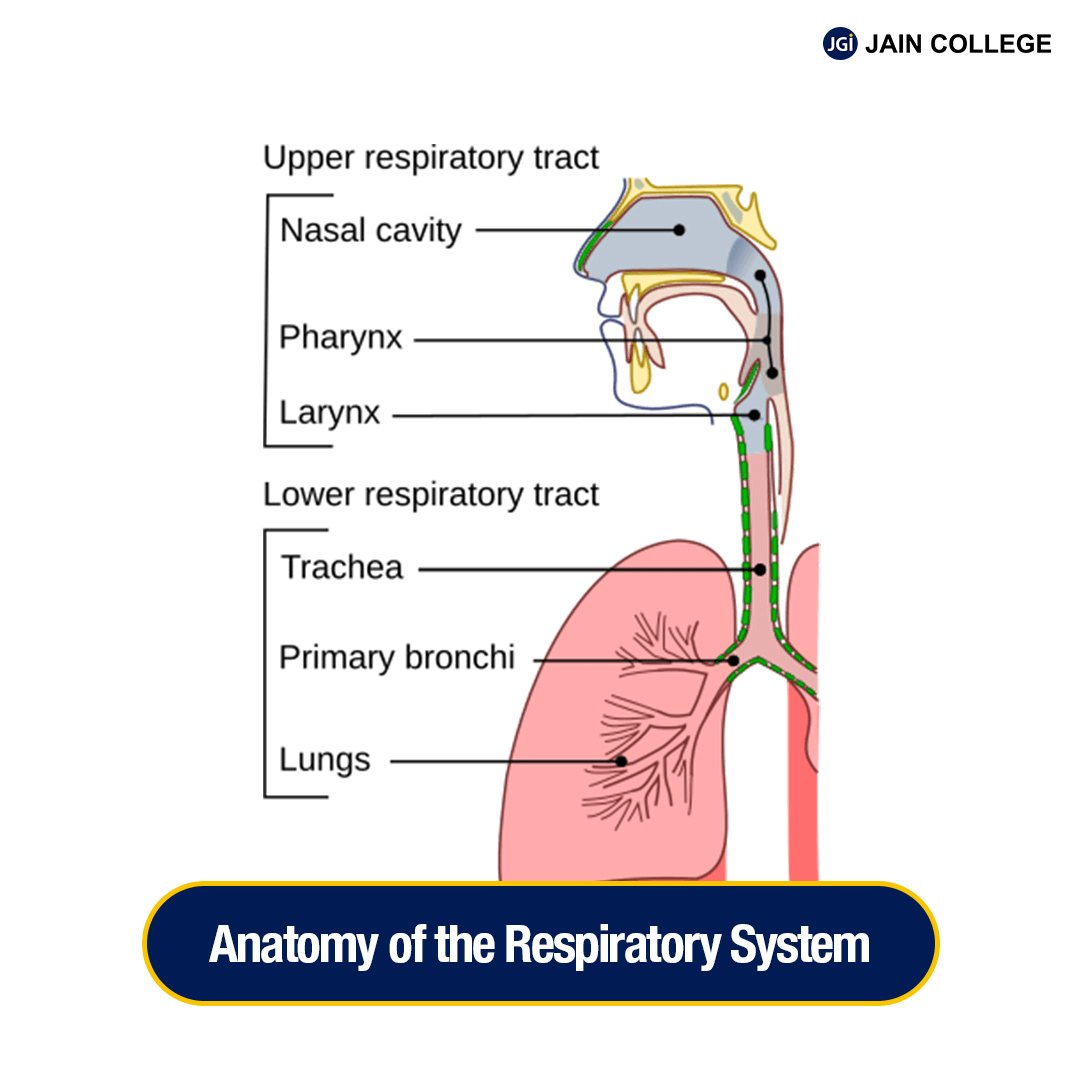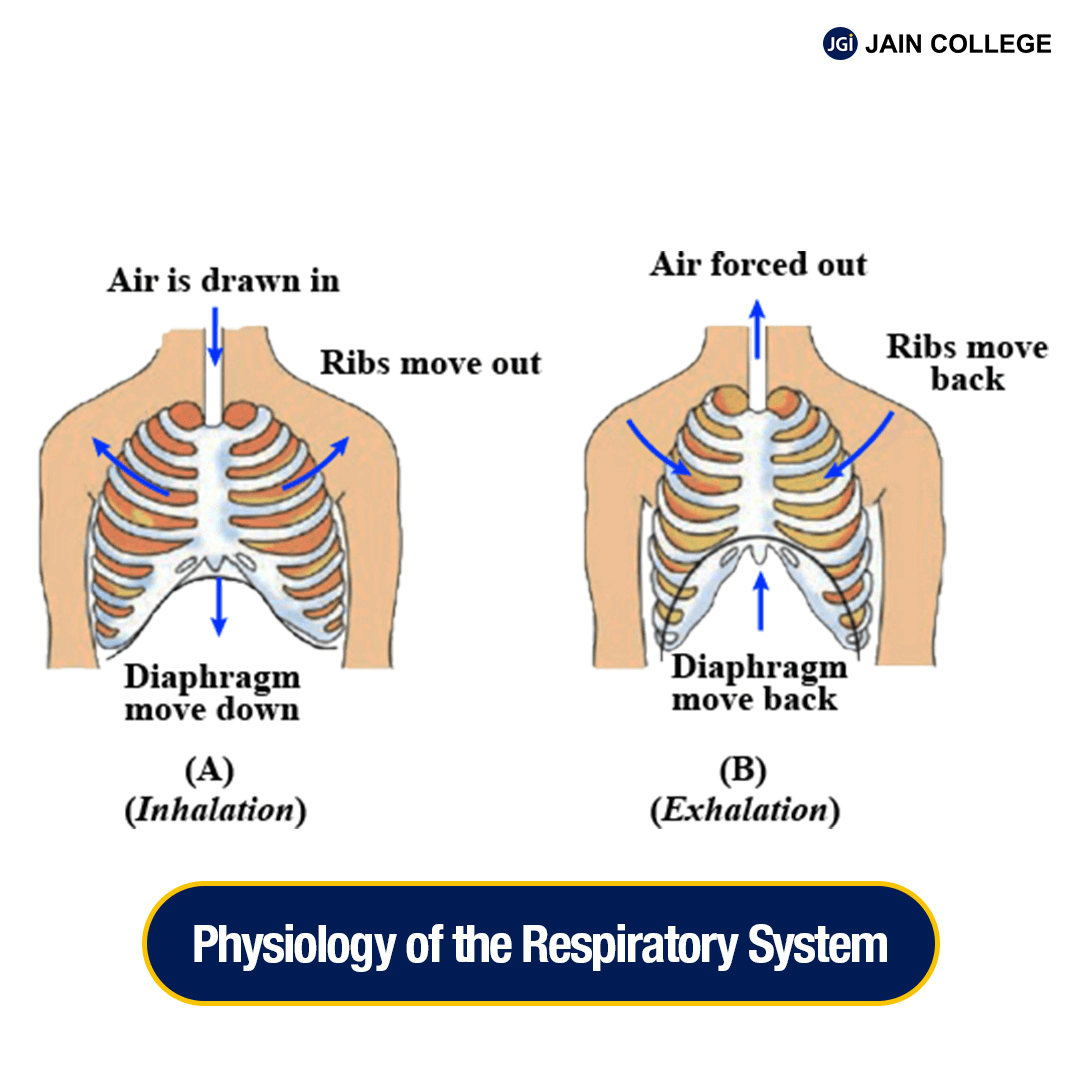
Breathing is something we do every second without even thinking about it, but have you ever wondered how it works?
The respiratory system is what allows us to take in oxygen and release carbon dioxide, keeping us alive and energised.
From our nose to our lungs, every part plays an important role in making sure our body gets the air it needs.
Understanding the respiratory system helps us appreciate how our body works and why taking care of our lungs is so important.
In this article, let us learn in detail about the respiratory system, its Anatomy, Physiology and some interesting facts.
The respiratory system is the part of our body that helps us breathe. It allows us to breathe in oxygen, which our body needs to survive, and breathe out carbon dioxide, which we do not need. Imagine it as a natural air filter that works all day and night without us even noticing!
Here is the Respiratory System Diagram:

It all starts when we breathe in through our nose or mouth.
This process keeps our body working, whether we are playing sports, studying, or even sleeping.
Without the respiratory system, we would not have the energy to do anything! That is why taking care of our lungs by breathing fresh air and avoiding harmful habits is important.
The main function of the respiratory system is to help us breathe!
The primary function of our respiratory system is to inhale or bring in oxygen for our body’s cells and remove or exhale carbon dioxide, a waste product. This process of inhaling and exhaling air is known as breathing.
This process of gaseous exchange takes place in the lungs, between the alveoli and the capillaries.
Other functions of the respiratory system include:

The human respiratory system is composed of the lungs, airways (trachea, bronchi, and bronchioles), diaphragm, voice box, throat, nose, and mouth that allow us to breathe.
It is divided into two sections based on its functions:
As we breathe, every part of the respiratory system plays a crucial role in ensuring we receive enough oxygen while removing waste gases.
Our respiratory system is divided into two parts: the upper and the lower respiratory tracts. Both work together to help us breathe smoothly.
The Upper Respiratory Tract:
The upper respiratory tract includes the nose, mouth, throat (pharynx), and voice box (larynx). It acts like a filter, cleaning the air we breathe and warming it before it reaches our lungs.
The Lower Respiratory Tract:
The lower respiratory tract includes the windpipe (trachea), lungs, and tiny air sacs (alveoli). This is where the real magic happens—oxygen enters our blood, and carbon dioxide is removed.
Together, these two parts ensure we get the oxygen we need while keeping harmful dust and germs out. Without them, breathing would not be as easy!
Our respiratory system is divided into two main parts: the upper and lower respiratory tracts. Even though they work together, they have different jobs!
| Upper Respiratory Tract | Lower Respiratory Tract |
| Includes the nose, mouth, throat (pharynx), and voice box (larynx) | Includes the windpipe (trachea), lungs, and tiny air sacs (alveoli) |
| Acts like a filter | Handles oxygen exchange |
| It cleans, warms, and moistens the air before it goes to the lungs | It brings oxygen into our blood and removes carbon dioxide |
| Helps us to talk, smell, and swallow | Keeps us breathing and energised |
In simple terms, the upper part prepares the air, while the lower part delivers oxygen to our body. Both respiratory tracts are super important for healthy breathing!
Breathing (spiration or ventilation) is the rhythmical process of moving air into (inhalation) and out of (exhalation) the lungs to facilitate gaseous exchange.
Thus, the physiology of the respiratory system is all about how we take in oxygen and get rid of carbon dioxide.
Physiology of the Respiratory System:

Let’s learn about the Physiology of the Respiratory System:
Here is how our respiratory system functions:
Inhalation (Breathing In) – When we breathe in, our diaphragm (a muscle under our lungs) moves down, creating space for air to rush into our lungs. Oxygen from the air enters tiny air sacs called alveoli.
Gas Exchange – In the alveoli, oxygen passes into our blood, and at the same time, carbon dioxide (a waste gas) moves out of the blood to be exhaled. This swap keeps our body fueled and removes what we do not need.
Exhalation (Breathing Out) – The diaphragm moves back up, pushing carbon dioxide out of the lungs and out of our body.
This breathing cycle happens automatically, all day and night, without us even thinking about it. That is why taking deep breaths, staying active, and keeping our lungs healthy is so important!
Pulmonology is the branch of medical science that focuses on the study of the respiratory system, lung function, diagnosing and treating respiratory diseases, including the lungs and other parts of the respiratory system.
The average person takes about 12–20 breaths per minute, approximately 20,000 breaths daily. The lungs are not identical; the right lung is divided into three lobes, while the left has only two lobes to accommodate space for the heart. The respiratory system helps maintain the body's acid-base balance by controlling carbon dioxide levels and bicarbonate ions in the blood.
Here are some interesting facts about the respiratory system:
Fact no. 1: The lungs are the only organs that can float on water
Fact no. 2: Many people in the world are living with just one lung
Fact no. 3: An average person breathes in around 11,000 litres of air every day
Fact no. 4: The sound of the voice also depends on how much air is being exhaled
Fact no. 5: During the respiratory cycle, a minimum of about 1,200 ml of air remains in our lungs
Fact no. 6: Children who breathe directly from the mouth will likely develop a lisp while talking
Fact no. 7: The nose has small bone-like shelves called turbinates, which act as a filter, heater and humidifier
Fact no. 8: Sneezing can exceed speeds of 100 miles per hour, and coughing can reach
speeds of up to 50 miles per hour
Fact no. 9: The right nostril will seem predominant during the daytime, and the left nostril will appear paramount during the nighttime
Fact no. 10: Breathing allows us to take in oxygen and expel carbon dioxide. But when we exhale, we also breathe out a lot of water
Fact no. 11: According to a 2012 article in the Official Journal of Polish Respiratory, we humans exhale up to 17.5 millilitres of water per hour
Fact no. 12: The human nose has four stages of filtration. The hairs inside the nose help filter unwanted things from entering the lungs
Fact no. 13: Yawning is one of the natural mechanisms which helps us to breathe more oxygen into the lungs when our brain senses a shortage of oxygen
Fact no. 14: Coughing and sneezing are natural mechanisms which keep our lungs clear of foreign substances and invaders you might unknowingly inhale
Fact no. 15: Studies have demonstrated that the lower respiratory tract is replete with diverse communities of bacteria both in healthy and diseased states
The respiratory system is like a natural air pump that never stops working. Doing so ensures that we get the oxygen we need while removing waste gases from our bodies. Without the respiratory system and its organs, it would be impossible for us to run, play, or even think properly!
That is why keeping our respiratory system healthy by avoiding pollution, exercising, and breathing fresh air is essential.
The more we understand how our body works, the better we can take care of it!
Read more about the respiratory system, its parts and functions, and learn some interesting facts about the human respiratory system on our blogs @ https://www.jaincollege.ac.in/blogs.
Join JAIN College for top-notch Science, Commerce, and Arts programmes. Secure your path to success today!
The Respiratory System is the part of our body that helps us to breathe! Its primary function is to inhale oxygen and exhale carbon dioxide to keep us alive and active.
The Respiratory System helps us breathe! It brings in oxygen and gets rid of carbon dioxide, keeping our body energised.
Air enters through the nose or mouth, travels down the trachea, into the lungs, and finally reaches tiny air sacs called alveoli, where oxygen is absorbed into the blood.
When we exhale, we get rid of carbon dioxide, a waste gas that our body does not need.
The diaphragm helps us breathe by moving up and down, creating space in our chest for air to enter and exit the lungs
The main organs of our respiratory system are the pair of lungs.
The respiratory system functions begin during the inhalation and exhalation process - when we breathe in or inhale, air goes through our nose or mouth, down the trachea, and into the lungs. Tiny air sacs called alveoli send oxygen into our blood and remove waste gases.
Oxygen plays a vital role in life. It is essential for cellular respiration, the process by which it also supports combustion. Oxygen gives our body energy, without it, we would not be able to move, think, or even survive.
One can keep our lungs healthier by breathing fresh air, avoiding smoking, exercising regularly, and avoiding pollution.
If breathing stops, our body can not get oxygen due to which our body quickly becomes deprived of oxygen, leading to loss of consciousness, and ultimately, death, if not addressed immediately.
Conditions that affect our respiratory system include:

JAIN PU College, a part of the renowned JGI Group, is committed to empowering students with quality education.
Beyond academics, the college ensures its online content reflects the same standard of excellence. Every blog and article is meticulously vetted and proofread by subject matter experts to ensure accuracy, relevance, and clarity. From insightful educational topics to engaging discussions, JAIN PU College's content is crafted to inform, inspire, and add value to its readers, reflecting the institution's commitment to intellectual growth and innovation.
View all Blogs